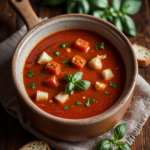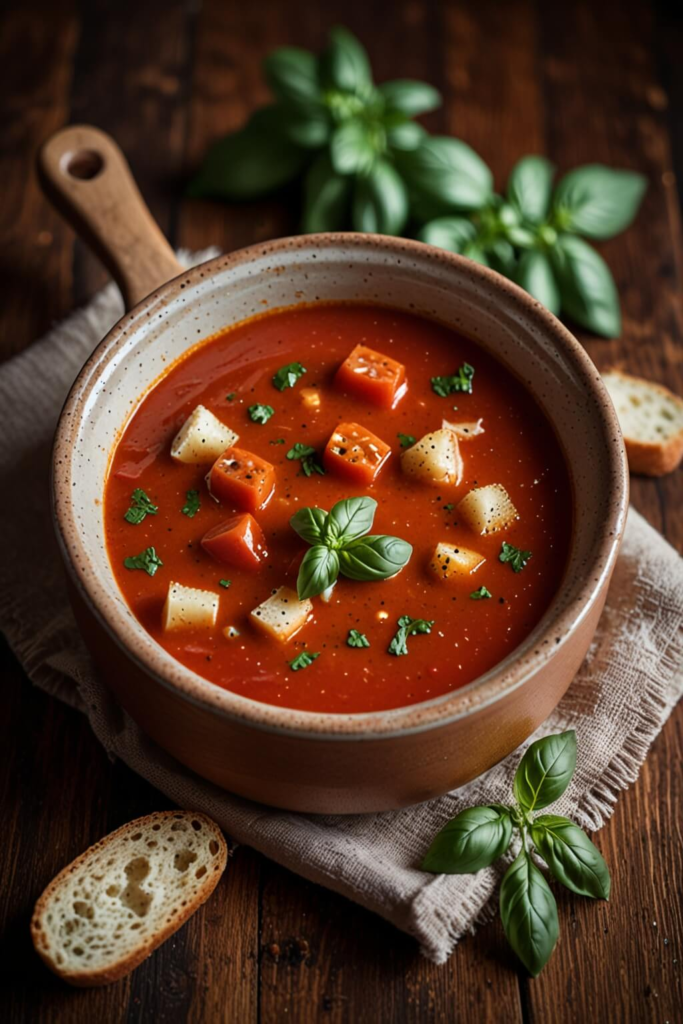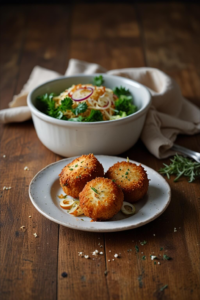Tomato Basil Soup is a classic dish that embodies comfort with its rich, creamy texture and vibrant flavors. Utilizing a slow cooker for this recipe enhances the experience even further, allowing the flavors to meld beautifully and making the cooking process delightfully simple. This introduction discusses why you should try making Tomato Basil Soup in a slow cooker and the essential elements for crafting a delicious version of this beloved soup.
Benefits of Using a Slow Cooker
Convenience and Time-Saving
The slow cooker offers unmatched convenience. Just prep your ingredients, place them in the cooker, and let it do the work. You won’t need to stand over a stove, stir consistently, or adjust temperatures. It’s a superb way to make the most of your time, enabling you to tackle other tasks or simply relax while your meal cooks.
Enhanced Flavor Development
Besides saving time, slow cooking helps in enhancing the flavors of your soup. The long cooking time allows a deeper melding of flavors, making your Tomato Basil Soup richer and more robust in taste.
Why Tomato Basil Soup?
Health Benefits
Tomatoes are a fantastic source of vitamins C and K, potassium, and fiber. They’re also high in antioxidants such as lycopene, which contributes to heart health and skin protection. Incorporating this nutritious fruit in a soup boosts its health benefits, making it a wholesome choice for any meal.
Versatility in Serving
Tomato Basil Soup can be enjoyed in various ways. It pairs beautifully with crusty bread, is perfect as a starter for any dinner, or can serve as a light main course. Furthermore, it can be easily adapted to suit vegetarian, vegan, or gluten-free diets, ensuring it’s a dish everyone can relish.
Ingredients Overview
Let’s take a closer look at what you’ll need for this tantalizing Tomato Basil Soup:
Key Ingredients Needed
Types of Tomatoes
The choice of tomatoes can significantly affect the texture and flavor of the soup. For a richer, more flavorful soup, opt for ripe, fresh tomatoes. However, canned tomatoes can also be used for convenience and year-round availability.
Fresh vs. Dried Basil
While dried basil can be used for a more concentrated flavor, fresh basil adds a bright, aromatic quality to the soup that is hard to beat.
Additional Flavor Enhancers
Garlic and Onions
These aromatics form the flavor foundation for countless recipes, including this one. They need to be sautéed until softened before being added to the slow cooker to release their full spectrum of flavors.
Broth and Spices
A good-quality vegetable or chicken broth can amplify the depth of the soup, while a thoughtful selection of spices like oregano, salt, and pepper can elevate the overall taste profile.
Setting up Your Slow Cooker
Choosing the Right Size
Size Recommendations
Opting for the right size of slow cooker is essential. For a family-sized serving of soup, a 4 to 6-quart cooker is typically sufficient.
Impact of Slow Cooker Size on Cooking
The size affects how the heat is distributed and retained. A cooker that’s too large can cause the soup to cook unevenly, whereas a small one might not accommodate all your ingredients properly.
Preparation Before Cooking
Layering Ingredients
To achieve the best results, start by layering the onions and garlic at the bottom, then top with tomatoes and basil. This arrangement helps in building flavors from the bottom up.
Initial Settings and Timing
Set your slow cooker on low for a gentle simmer that enhances flavor development. Typically, 6-8 hours should be enough to cook the soup thoroughly.
By using these guidelines, you’re all set to create a delicious and hearty Tomato Basil Soup in your slow cooker, which is sure to be a hit at any dining table. Making this soup is not just about following a recipe—it’s about experiencing the magic of slow cooking and the delightful simplicity it brings into your culinary life.
The Cooking Process
Step-by-Step Cooking Instructions
- Layering Ingredients in the Cooker: Begin by placing the finely chopped onions and garlic at the bottom of the slow cooker. Layer the tomatoes on top, ensuring they are spread out evenly. This layering technique allows the onions and garlic to release their flavors directly into the base, enhancing the overall taste of the soup.
- Cooking Duration and Temperatures: Set your slow cooker to low and let the soup cook for 6 to 8 hours. Alternatively, if you’re short on time, you can set it to high for 3 to 4 hours. Cooking on low temperature for a longer time helps in maximizing the flavors.
Mid-Cooking Adjustments
- Stirring and Tasting: Halfway through the cooking time, give the soup a good stir to mix the flavors. This is also a perfect moment to taste and make any necessary adjustments.
- Adjusting Spices and Flavors: Depending on your taste, adjust the salt, pepper, and basil. If the soup tastes too acidic, a pinch of sugar can help balance the flavors.
Finishing Touches
- Adding Cream or Alternative Cream Options: For a richer texture, stir in some cream or a dairy-free alternative such as coconut cream during the last 30 minutes of cooking. This addition brings a smooth, creamy consistency to the soup.
- Final Seasoning Adjustments: Perform a final taste test and adjust the seasonings if needed. More basil can be added for a fresher taste, or a pinch of chili flakes can introduce a slight kick.
Blending Techniques
Smooth vs. Chunky Soup Preferences
- How to Achieve Desired Consistency: For a smooth soup, use an immersion blender right in the pot to blend the soup to your desired consistency. If you prefer it chunky, blend only half of the soup and mix it with the chunkier half.
- Tools for Blending: Immersion Blender vs. Countertop Blender: An immersion blender is convenient for blending directly in the slow cooker, reducing cleanup. A countertop blender can work as well but might require blending in batches.
Safety Precautions When Blending Hot Ingredients
- Cooling Before Blending: Allow the soup to cool slightly before blending to prevent pressure from building up in the blender, which can cause spills or burns.
- Proper Handling and Operation of Blenders: Always ensure the lid is secure when using a countertop blender, and start with the lowest speed, gradually increasing to prevent the hot soup from erupting.
Enhancements and Variations
Incorporating Protein
- Adding Chicken or Beans: To make your soup a heartier meal, stir in some pre-cooked chicken or canned beans in the last hour of cooking.
- Considerations for Cooking Time with Added Proteins: Adding proteins like chicken might require adjustments in cooking time, so ensure everything is cooked thoroughly before serving.
Vegan and Vegetarian Options
- Substitutes for Cream: For vegan options, consider using plant-based creams like cashew or almond cream.
- Additional Vegetable Add-ins: Enhance the soup with other vegetables such as carrots, celery, or potatoes for added flavor and nutrition.
With these detailed steps and options, you can create a flavorful, comforting tomato basil soup that can be customized to suit any dietary needs. Lastly, don’t forget to enjoy the process as your kitchen fills with the delightful aromas of your delicious creation!
Serving Suggestions
Accompaniments
When it comes to serving your slow cooker tomato basil soup, the right accompaniments can transform it from a simple dish to a splendid meal. Choosing the perfect bread or crackers is crucial. For instance, a crunchy baguette or garlic bread can elevate the flavors, while a selection of artisanal crackers can provide a delightful texture contrast. Besides that, consider pairing your soup with a fresh salad. A crisp green salad with a light vinaigrette or a Caesar salad can offer a refreshing balance to the hearty soup.
Presentation Tips
Presentation plays a key role in enhancing the dining experience. Here are some tips to present your tomato basil soup elegantly:
- Garnishes and Toppings: A sprinkle of freshly chopped basil, a dollop of cream, or some shaved parmesan can add visual appeal and layers of flavor.
- Soup Bowls and Plating: Choose bowls that complement the color and texture of the soup. Warm, earthy tones or classic white bowls are always appealing. Ensure the bowls are pre-warmed so the soup stays hot while serving.
Storing and Reheating
Best Practices for Storing
To maintain the freshness and flavor of your tomato basil soup, proper storage is essential:
- Cooling Down and Refrigerating: Allow the soup to cool to room temperature before refrigerating. Store it in an airtight container to keep it fresh and prevent absorption of other flavors from the fridge.
- Freezing Methods: For longer storage, freezing is an excellent option. Use freezer-safe bags or containers and leave some room for expansion.
Reheating Without Losing Flavor
Reheating your soup properly can ensure it tastes just as good as when it was fresh:
- Optimal Reheating Techniques: Reheat the soup slowly on the stove over medium heat to help preserve its flavors and textures.
- Common Mistakes to Avoid: Avoid using high heat for reheating, as it can cause the soup to burn or become unevenly hot.
Engaging With Your Audience
Encouraging Reader Feedback
Interacting with your readers can bring valuable insights and build a community around your cooking:
- Requesting Comments on Variations: Encourage your readers to share their own twists on the recipe. Whether they incorporated different spices or added proteins, their experiences can inspire others.
- Sharing Personal Experiences: Share stories about what inspired you to create the dish, or any tips you’ve learned along the way to invite readers to connect on a more personal level.
Using Visuals and Social Media
Visuals can significantly enhance how your recipe is received:
- Engaging Through Photos: Post high-quality images of your cooking process and the final product. These can entice people to try the recipe themselves.
- Promoting Your Recipe on Social Platforms: Utilize platforms like Instagram, Pinterest, and Facebook to share your recipe. Engage with your followers by posting engaging content like quizzes about their favorite soup or behind-the-scenes videos of your cooking process.
By following these tips and techniques, not only will you ensure your tomato basil soup is a success, but you’ll also enhance your engagement with a community of fellow food enthusiasts.
Print
Slow Cooker Tomato Basil Soup
- Temps total: 6 hours 15 minutes
- Rendement: 4 servings 1x
Description
This Slow Cooker Tomato Basil Soup combines fresh basil and tangy tomatoes, simmered to perfection. It’s a comforting and easy dish perfect for any day.
Ingrédients
- 28 oz. canned crushed tomatoes
- 1 cup chopped carrots
- 1/2 cup chopped celery
- 1/4 cup minced sweet onion
- 2 cloves garlic, minced
- 4 cups vegetable broth
- 1/3 cup fresh basil, chopped
- 1 tsp sea salt
- 1/2 tsp black pepper
- 1/2 cup heavy cream (optional)
- Fresh basil leaves for garnish
Préparation
- Prepare the vegetables and place them along with the crushed tomatoes and vegetable broth in a slow cooker.
- Cook on low for 5-6 hours.
- Add chopped basil, salt, and pepper.
- Puree the soup if desired and add heavy cream before serving. Garnish with fresh basil.
Remarques
- Dairy-free option: Skip the heavy cream or use almond/coconut milk.
- Enhance flavor: Consider roasting tomatoes and garlic.
- Spicy version: Add crushed red pepper.
- Préparation: 15 minutes
- Cuisson: 5-6 hours
- Catégorie: Soup
- Méthode: Slow Cooker
- Cuisine: Italian
Nutrition
- Serving Size: 1 bowl
- Calories: 200
- Sugar: 10g
- Sodium: 700mg
- Fat: 9g
- Saturated Fat: 5g
- Unsaturated Fat: 3g
- Trans Fat: 0g
- Carbohydrates: 25g
- Fiber: 4g
- Protein: 4g
- Cholesterol: 27mg
Mots clés: tomato soup, slow cooker, easy recipe




